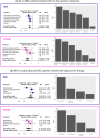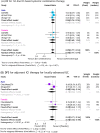Impact of sex on the efficacy of immune checkpoint inhibitors in kidney and urothelial cancers: a systematic review and meta-analysis
- PMID: 37209143
- PMCID: PMC10352444
- DOI: 10.1007/s00345-023-04412-0
Impact of sex on the efficacy of immune checkpoint inhibitors in kidney and urothelial cancers: a systematic review and meta-analysis
Abstract
Purpose: To analyze and summarize the efficacy of immune checkpoint inhibitor (ICI) alone or in combination therapy for renal cell carcinoma (RCC) and urothelial carcinoma (UC) stratified by sex.
Methods: Three databases were queried in October 2022 for randomized controlled trials (RCTs) analyzing RCC and UC patients treated with ICIs. We analyzed the association between sex and the efficacy of ICIs in RCC and UC patients across several clinical settings. The outcomes of interest were overall survival (OS) and progression-free survival for the metastatic setting and disease-free survival (DFS) for the adjuvant setting.
Results: Overall, 16 RCTs were included for meta-analyses and network meta-analyses. In the first-line treatment of metastatic RCC (mRCC) and UC (mUC) patients, ICI-based combination therapies significantly improved OS compared to the current standard of care, regardless of sex. Adjuvant ICI monotherapy reduced the risk of disease recurrence in female patients with locally advanced RCC (pooled hazard ratio [HR]: 0.71, 95% confidence interval [CI] 0.55-0.93) but not in male patients, and, conversely, in male patients with muscle-invasive UC (pooled HR: 0.80, 95%CI 0.68-0.94) but not in female patients. Treatment ranking analyses in the first-line treatment of mRCC and mUC showed different results between sexes. Of note, regarding adjuvant treatment for RCC, pembrolizumab (99%) had the highest likelihood of improved DFS in males, whereas atezolizumab (84%) in females.
Conclusions: OS benefit of first-line ICI-based combination therapy was seen in mRCC and mUC patients regardless of sex. Sex-based recommendations for ICI-based regimens according to the clinical setting may help guide clinical decision-making.
Keywords: Adjuvant; Advanced; Gender; Immune checkpoint inhibitors; Metastatic; Renal cell carcinoma; Sex; Urothelial carcinoma.
© 2023. The Author(s).
Conflict of interest statement
Takahiro Kimura is a paid consultant/advisor of Astellas, Bayer, Janssen and Sanofi. Shahrokh F. Shariat received follows: Honoraria: Astellas, AstraZeneca, BMS, Ferring, Ipsen, Janssen, MSD, Olympus, Pfizer, Roche, Takeda Consulting or Advisory Role: Astellas, AstraZeneca, BMS, Ferring, Ipsen, Janssen, MSD, Olympus, Pfizer, Pierre Fabre, Roche, Takeda Speakers Bureau: Astellas, Astra Zeneca, Bayer, BMS, Ferring, Ipsen, Janssen, MSD, Olympus, Pfizer, Richard Wolf, Roche, Takeda, The other authors declare no conflicts of interest associated with this manuscript.
Figures




Comment in
-
Relationship between sex and immune checkpoint inhibitors in urothelial carcinoma and renal cell carcinoma.World J Urol. 2023 Aug;41(8):2301-2302. doi: 10.1007/s00345-023-04497-7. Epub 2023 Jul 6. World J Urol. 2023. PMID: 37410104 No abstract available.
Similar articles
-
Impact of Clinicopathological Features on Survival in Patients Treated with First-line Immune Checkpoint Inhibitors Plus Tyrosine Kinase Inhibitors for Renal Cell Carcinoma: A Meta-analysis of Randomized Clinical Trials.Eur Urol Focus. 2022 Mar;8(2):514-521. doi: 10.1016/j.euf.2021.03.001. Epub 2021 Mar 11. Eur Urol Focus. 2022. PMID: 33714725 Review.
-
First-line immune-checkpoint inhibitor combination therapy for chemotherapy-eligible patients with metastatic urothelial carcinoma: A systematic review and meta-analysis.Eur J Cancer. 2021 Jul;151:35-48. doi: 10.1016/j.ejca.2021.03.049. Epub 2021 May 4. Eur J Cancer. 2021. PMID: 33962359
-
Single or combined immune checkpoint inhibitors compared to first-line platinum-based chemotherapy with or without bevacizumab for people with advanced non-small cell lung cancer.Cochrane Database Syst Rev. 2020 Dec 14;12(12):CD013257. doi: 10.1002/14651858.CD013257.pub2. Cochrane Database Syst Rev. 2020. Update in: Cochrane Database Syst Rev. 2021 Apr 30;4:CD013257. doi: 10.1002/14651858.CD013257.pub3. PMID: 33316104 Free PMC article. Updated.
-
Novel combination therapy for platinum-eligible patients with locally advanced or metastatic urothelial carcinoma: a systematic review and network meta-analysis.Cancer Immunol Immunother. 2025 Feb 1;74(3):76. doi: 10.1007/s00262-024-03910-3. Cancer Immunol Immunother. 2025. PMID: 39891702 Free PMC article.
-
Single or combined immune checkpoint inhibitors compared to first-line platinum-based chemotherapy with or without bevacizumab for people with advanced non-small cell lung cancer.Cochrane Database Syst Rev. 2021 Apr 30;4(4):CD013257. doi: 10.1002/14651858.CD013257.pub3. Cochrane Database Syst Rev. 2021. PMID: 33930176 Free PMC article.
Cited by
-
Letter to the editor for the article "Comparison between different neoadjuvant chemotherapy regimens and local therapy alone for bladder cancer: a systematic review and network meta-analysis of oncologic outcomes".World J Urol. 2023 Oct;41(10):2875-2876. doi: 10.1007/s00345-023-04575-w. Epub 2023 Sep 5. World J Urol. 2023. PMID: 37668720 No abstract available.
-
The influence of sex hormones on renal cell carcinoma.Ther Adv Med Oncol. 2024 Aug 21;16:17588359241269664. doi: 10.1177/17588359241269664. eCollection 2024. Ther Adv Med Oncol. 2024. PMID: 39175990 Free PMC article. Review.
-
Adjuvant Immune Checkpoint Inhibitors for Muscle-Invasive Urothelial Carcinoma: An Updated Systematic Review, Meta-analysis, and Network Meta-analysis.Target Oncol. 2025 Jan;20(1):57-69. doi: 10.1007/s11523-024-01114-4. Epub 2024 Nov 13. Target Oncol. 2025. PMID: 39535690
-
Advancements in systemic therapy for muscle-invasive bladder cancer: A systematic review from the beginning to the latest updates.Bladder Cancer. 2025 Apr 25;11(2):23523735251335122. doi: 10.1177/23523735251335122. eCollection 2025 Apr-Jun. Bladder Cancer. 2025. PMID: 40296876 Free PMC article. Review.
-
Sex differences in cancer and immunotherapy outcomes: the role of androgen receptor.Front Immunol. 2024 May 28;15:1416941. doi: 10.3389/fimmu.2024.1416941. eCollection 2024. Front Immunol. 2024. PMID: 38863718 Free PMC article. Review.
References
Publication types
MeSH terms
Substances
LinkOut - more resources
Full Text Sources
Medical

